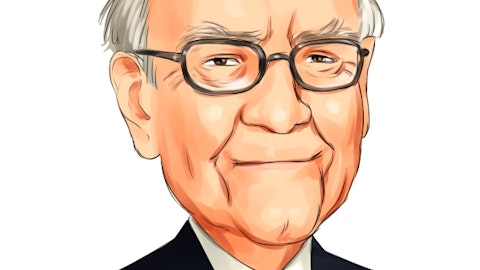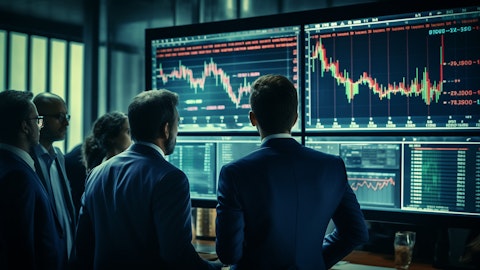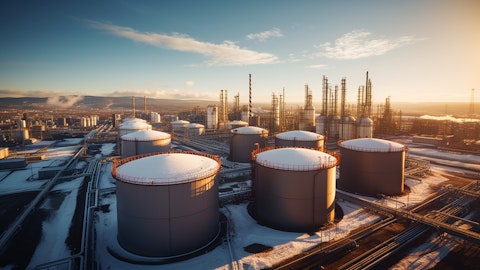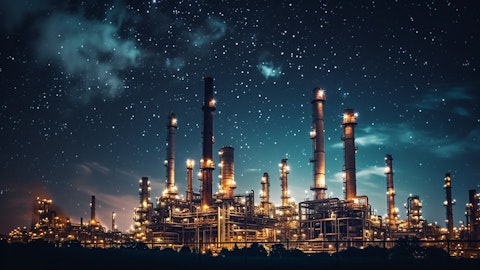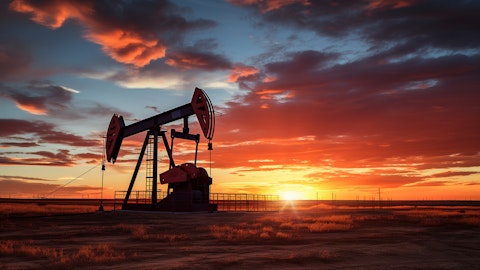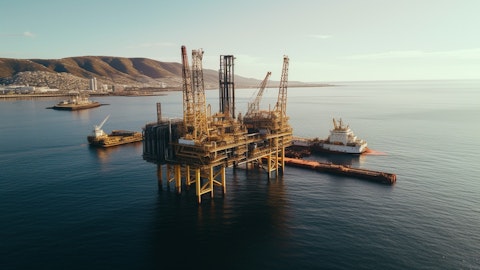Vicki Hollub: And I would add the other place where we did add significant reserves was Algeria. As a result of the team’s work to get all the 18 contracts merged into one and then extended. So that was great work done by the Algeria team to add reserves there. But the thing I’m most proud of is, while the bulk of the reserves came from those two sources, the Permian and Algeria, and a little bit from the DJ, every business unit we have increased reserves except for Al Hosn where we had already booked quite a bit of reserves because of the modeling work done there to get that estimate more refined.
John Royall: Thank you.
Vicki Hollub: Thank you.
Operator: The next question, excuse me, the next question is from David Deckelbaum with TD Cowen. Please go ahead.
David Deckelbaum: Good afternoon. Thanks for taking my questions today. I just wanted to follow up a little bit.
Vicki Hollub: Hi, David.
David Deckelbaum: Just — thanks. I wanted to follow up a little bit just on that prior conversation around EOR. I guess this is being built out in conjunction with some of the anticipated volumes coming from STRATOS. Can you give us a sense what sort of capacity in terms of production relative to where you’re at today? You’re intending to build out, or I guess, thought another way. How large do you anticipate the growth rate to be out of the EOR production base over the next five years to 10 years?
Vicki Hollub: I would say that over the next five years to 10 years, it’s going to be a significant part of our portfolio development. We have 2 billion barrels of resources remaining to be developed and we believe that as a result of our Direct Air Capture facilities that we ultimately will build to get CO2 out of the atmosphere, it’s going to be the most sustainable barrels in the world. It’s going to be a resource that the world needs to get to leave 30% or 40% of oil in conventional reservoirs, and 90% of oil in shell reservoirs. It’s just not acceptable. And for the United States to continue our energy independence, EOR is going to have to be a part of the equation. Ultimately, we’re getting way ahead of the game here to be sure that we’re ready, because we do believe that the climate transition would not be affordable for the world without EOR being able to produce net zero carbon barrels of oil.
So this is a huge part of our strategy and important not only to our shareholders who love value, but to the U.S., and ultimately, to other parts of the world. And for the nearer term, a forecast on what we can do, Richard has some data on that.
Richard Jackson: Yeah. Perfect. I’ll tie that. I mean, one of the attributes we really like around the EOR production that we talk about a lot is the lower decline. So as we came through the last several years, especially through the downturn with lower commodity prices, being able to have that flat — flatter decline, less than 5%, was able to help us maintain a lot of free cash flow. We really started restoration of some of that development last year, and this year as we go forward, we’ll have about 60 wells that we’ll bring online, which will add about 4,000 barrels a day of new well production. But the benefit of this EOR and we talk about mid-cycle, that doubles next year and triples in the third year. So you really hit your peak production of around 12,000 barrels a day based on that investment today three years from now.
The other thing I mentioned shortly, but just to provide a little more color, the Seminole gas plant expansion, that’s about 85 million a day that we’ll add in terms of capacity for about $40 million. Again, this year we’ll expect a couple of thousand barrels a day that we’ll add in our base production. So if you think about kind of a cash investment intensity or capital intensity, that’s as competitive as we’ve got in the portfolio. But what it does, to Vicki’s point, is we’re able to bring on our CO2, anthropogenic CO2 for the future. These are very good return projects. They’ll be very competitive in our portfolio, especially given the lower decline. So when we look at just that Seminole, as we look 2024 to 2028, that’s another 15,000 barrels a day to 20,000 barrels a day type opportunity for minimal capital.
So within sort of the range of capital that we’re spending this year in EOR, we’re building those sort of wedges with great opportunity to do more as we bring on more CO2. So hopefully that helps tie the short and the long.
David Deckelbaum: I appreciate the details, Richard. Maybe just sticking with the theme as a follow-up, just — I think you talked a little bit about some spending is in the budget this year for the second DAC facility, I guess, in Kleberg. Is any part of that sort of progression, excuse me, still contingent on conversations with the DoE and is – are you expecting a resolution around finality of funding and grants this year?
Vicki Hollub: The discussions with the DoE are continuing and going quite well. That — where we — the timing of the start of the front-end engineering and design will be dependent on the completion of some of those discussions and then the discussions will continue beyond that on getting prepared for the start of construction. But there is a timeline there that we’re working through.
Richard Jackson: Maybe just a couple of details I’ll add since you asked the question on that. I mean, a lot of that spend is continuing to build out the subsurface capability for that CO2. Obviously, Direct Air Capture is an anchor for the King Ranch area, but we continue to work on our other Gulf Coast tubs. We’ve submitted eight Class VI and are expected to submit another 10 this year. So just kind of giving you a scale of what that type of work has been going there. So it’s going really well. I’m really pleased with the development work on that end, and then, obviously, Carbon Engineering, we’ve been getting to work more and more with, and I’m really happy with the progress that is going through R&D to project work with Ken that will fulfill that development work.
David Deckelbaum: Thank you both.
Operator: The next question is from Roger Read with Wells Fargo Securities. Please go ahead.
Roger Read: Yeah. Thanks. Good afternoon. I guess I’d like to come back to two things, please, Vicki. First one on the CrownRock, if there’s anything you can kind of offer us on what the FTC is asking you for a second request. And I’ll just sort of preface with, I understand with some of the more integrated companies, the concern of concentration. I’m a little more surprised in a more upstream-oriented company. So anything you can help us with there?
Vicki Hollub: Well, some of our teams felt like they’d asked for everything. But I can tell you our teams are working diligently to work with the team at the FTC to get them all the answers that they need. So it’s — we’re progressing and hope to, as we said, be able to close in the second half of this year.
Roger Read: So they asked for the moon and everything else?
Vicki Hollub: I didn’t — well, I didn’t see the moon on there, but we’re not done yet.
Roger Read: Fair enough. All right. The other question I had in terms of the capital efficiencies are obviously coming through in the Permian. The regular, let’s call it, still modest growth there. But you’re increasing the growth rate during 2024 for the Rockies and other part of it. When we had the follow-up calls yesterday, they said part of it was, building some mid-cycle businesses, maybe some somewhat lower declined businesses. I was just wondering, from a corporate structure, how you make the decision on where to allocate the growth capital here, like, why lean more into the Rockies and the EOR rather than the Permian when we’re kind of all conditioned to thinking of the Permian as among the best returns in the business, and obviously, the performance you’ve been delivering at the wellhead kind of says, well, why not more capital in the Permian rather than these other opportunities?
Vicki Hollub: Well, when you look at it on a corporate level, what we’re really trying to do is balance our investments over time so that we can have a sustainable growing dividend. And it’s — we’ve got this unique balance that I think makes it for us different than many other companies and we want to take full advantage of it. And I want to let Richard and Sunil chime in on their views on it, because this is a critical part of what differentiates us.
Richard Jackson: Yeah. No. Roger, appreciate the opportunity. I mean, obviously, we’re putting together short-term with long-term in mind and the CrownRock acquisition provides a lot of growth and we’ve talked about the positive attributes of that being a more mature unconventional development with high margin, 35% decline. It immediately adds, you can think about it from a growth standpoint, a really nice growth wedge this year, both from a free cash flow basis, but also a decline basis. The Rockies, I’ll just pick on one point there, about 40% of that capital in the Rockies this year has to do with drilled uncompleted wells that carried in from last year, sort of the cadence of that activity levels, we had resumed activity last year, got ahead on the drilling and then this year really beginning to complete a lot of those wells.
So from a capital intensity standpoint, that’s very, very low when you look at what we’re spending for the amount of production that we’re able to add there. Obviously, that’s — we have high margins in the Rockies. We have royalties. There’s other things that drive very competitive returns there. And so, that duck count, just as a data point, will kind of go from, say, mid-60s, kind of the fourth quarter of last year to more like mid-30s as we balance and that’s allowing us to then actually pull back about a half of a net rig in the Rockies to more of a sustainable activity level. So just a little color on the Rockies so we don’t read too much into just one year. But maybe Sunil can then pick that up and talk kind of across the company.
Sunil Mathew: Yeah. So when we think about capital allocation in the oil and gas segment, what we’re trying to do is we’re trying to balance between margin, base decline and capital flexibility. So if you start with cash margin, we start with the U.S. unconventional with high margin, high returns and based on everything we’ve heard so far, it’s getting better each year. And then you have Gulf of Mexico, which has one of the highest cash margin in our portfolio. And if you look on an incremental basis, it’s even higher because a large part of the operating cost is fixed. And then you have international assets, which are mostly production sharing encompass [ph], where we get a higher share of production at lower prices and this helps mitigate some of the commodity price risk and protect the overall cash margin.
